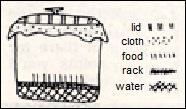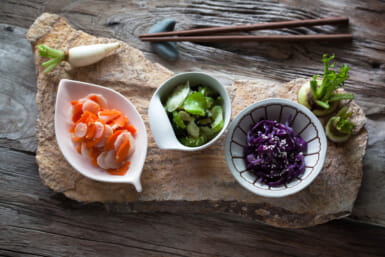with Elizabeth Andoh
Have you ever wondered just what it is that the average Japanese citizen eats every day? If you suspect that tourist-sukiyaki, instant ramen (noodles) or elaborately garnished kai-seki (full-course, formal dinner) is not daily fare, you’re right.
What the average person eats is called, simply enough, katei ryori or “home cooking.” Of course it varies some from home to home and there are regional difference, too. But there are many standard dishes that could be found in any home.
Katei ryori tends to be more economical than fancy foods. It’s nutritious, tastes great (quite literally “just like Mother used to make”) and is fairly simple to prepare (housewives, not master chefs, can and do prepare such foods dally).
But for most foreign residents, katei ryori remains unknown. Few restaurants offer “the real thing”. And on the rare occasion when you might be invited into someone’s home, you are okyakusama (honored guest) and home cooking is not considered suitable for okyakusama – Japanese or foreign. Of course, ladies magazines and periodicals devoted specifically lo food such as NHK’s Kyo No Ryori (Today’s Cooking) or Eiyo to Ryori (Nutrition and Cooking) are filled with basic recipes and myriad variations. But unless you can read Japanese it won’t help you very much
Devoted primarily to kalei ryori, this column will present basic recipes and techniques and introduce ingredients that may be unfamiliar to the average Western resident. It will also introduce and explain equipment and “appliances” used often in food preparation.
All recipes, unless otherwise noted, are intended for five to six rice-eating adults or three or four non-rice-eating adults. For convenience in shopping, all purchased items will be given in grams, centimeters etc.
For procedures performed at home, though, I’ve used standard American measuring cups and spoons and inches. I’ll be referring to previous recipes, so please clip out this column and save it. I’ll have to repeat some information at regular intervals (every six months?), but hope not to bore the regular reader.
The difference between native Japanese cooking and all other cuisines may best be stated as the difference between water and oil. Traditional methods of food preparation in Japan, were water based steaming, braking, boiling even soup stocks are free of fats or oils.
Frying, sauteing, and the use of animal fats and cooking were foreign innovations, although they have been well assimilated into the modern diet. In this process of assimilation, many new truly Japanese dishes emerged – like tempura (batter fried fish and vegetables) and tonkatsu (fried pork cutlets), to mention a few.
Steaming, followed by braising in a flavored broth to one of the more typical methods of preparing vegetables that require a long time in cooking. Such vegetables as kabocha (squash, pumpkin) and imo (potatoes) are usually fixed this way. For this type of cooking you’ll need a steamer like the one pictured here. It can be purchased, or improvised by placing a rack (with perforations of some kind) over boiling water in a pot with a tight fitting lid.
There should be at least two inches of water beneath the rack, and the rack should stand on “feet” or be otherwise supported (not floating on the water). A cloth placed between the pot and lid prevents the food from water-spotting.
For braising, Japanese-style, you’ll need an otoshi buta (dropped lid). As the name implies, the lid doesn’t rest on the rim of the pot, but drops down inside the pot and lies directly on the food. Tills forces the braising liquid into the food being cooked and prevents the food surface from drying out as the liquid evaporates.
Ideally, the otoshi buta should be two cms. (less than one inch) smaller in diameter than the pot in which it is being used. The lids are made from sugi wood (Japanese cedar) and become self-seasoned with use. After each time, they should be washed quickly with warm sudsy water and rinsed thoroughly. Don’t leave them soaking in soapy water for long periods of time or you’ll find your food likewise flavored.
A 20-centimeter star lid will cost around ¥400 and may be found in the katei yohin (housewares) section of any large department store.
Today’s recipes are for dashi (basic soup stock), kabocha (summer squash— dark green outside, pale yellow inside) to be served with or without tori-an-kake (chicken meat “gravy”).
DASHI (soup slock, yields approximately 4 1/2 cups)
ingredients:
- 5-6 inches dashi konbu
- 1 cup (very loosely piled in) katsuo bushi
- 5 cups cold water
- seasonings: 1 1/2 teaspoons usuguchi shoyu
1 teaspoon salt
a dash of MSG (optional)
instructions:
1. Put 5 cups fresh cold water into a fairly large pot. Add dashi konbu and bring it to a boil over high heat, uncovered.
2. Remove the konbu once the water has begun to boi. Add the katsuo bushi and turn off the heat.
3. Let it stand for one minute (the katsuo is beginning to sink). Strain the stock through cheesecloth and a strainer into a large bowl.
4. Season just before using.
notes:
1. konbu or dashi konbu is a kind of seaweed used to flavor soups and broths. Several long dark strips come in small cellophane packages (cost around ¥100) and these can be cut with a scissors. Keep in a dry, cool place. The white film is not mold, but often sand particles cling to the konbu and therefore the konbu should be gently rinsed right before using.
2. katsuo bushi are flakes of dried bonito fish. A small package of already shaved katsuo (looks somewhat like wood shavings) should coat around ¥100, although there are all grades and qualities. Store same as konbu.
3. usugushi shoyu is “light” soy sauce – the color is thinner than regular soy sauce, but the flavor is a bit saltier. Regular or “dark” soy sauce to referred to merely as shoyu. When buying, check the label with someone who can read Japanese (like the salesclerk).
4. Dashi will keep, refrigerated 2-3 days. It may be frozen, but with loss of flavor.
KABOCHA NO NIKOMI (steamed, braised squash)
ingredients:
- 1 small squash
- nijiru: 1 1/2 cups unseasoned dashi
6 1/2 tablespoons sugar
2 1/2 tablespoons usugushi shoyu
1 tablespoon sake
instructions:
1. Slice the kabocha into wedges (10-12 depend-most of the outer darking on size) and peel green away (leave what naturally remains between ridges). Remove seeds.
2. Place wedges on the rack of a steamer and steam until barely tender (about 8-10 minutes from time steam starts).
3. Combine the nijiru ingredients in a pot and heat through to dissolve the sugar.
4. Add squash to the nijiru (as level as possible) and place otoshi buta on ton. Braise over medium heat for abour 8-10 minutes.
5. Serve one or two wedges in individual bowls. Pour some of the remaining nijiru over the squash, or nap with the tori-an-kake sauce below. The squash alone or with nijiru is good room temperature, too, though the sauce below is best served hot.
notes:
1. nijiru is “cooking liquid,” usually a flavored broth.
2. Unless otherwise noted, sugar in Japanese cooking is white, ungranulated sugar. Granulated sugar tends to make the finished dish, in most recipes, gritty in texture. Measure loosely, not packed down into spoon.
3. sake is Japanese wine made from rice. All qualities are available, but a cheap brand is fine for cooking.
TORI-AN-KAKE (sauce or gravy)
ingredients:
- 100 grams ground chicken meat (lean)
- nijiru: 1/2 cup dashi
2 tablespoons shoyu
2 1/2 tablespoons sugar
or
- strain remaining nijiru from the squash, add a few drops of shoyu (approx. 1 teaspoon); 1 tablespoon each cold water and cornstarch
instructions:
1. mix nijiru ingredients in saucepan and heat thru until the sugar is dissolved.
2. add chicken meat and stir over medium heat, breaking up large clumps. Cook until chicken meat has turned white. If any fat floats on the top, blot (with paper towel) or skim off.
3. thicken with the water and cornstarch and pour over squash.
notes:
1. shoyu here means regular soy sauce
2. ground chicken meat is tori hiki niku









